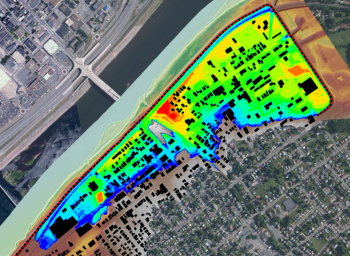Consequence Analysis

|
| 2D hydraulic modeling can be used to simulate and estimate the consequences of dam and levee failures.
(Image Source: Gannett Fleming) |
Hazard potential is defined as the possible adverse incremental consequences that result from the release of water or stored contents due to failure of the dam or mis-operation of the dam or appurtenances. When considering negative impacts or adverse consequences that may result from the failure of the dam, the primary concerns are loss of human life, economic loss (including property damage), lifeline disruption, and environmental impact. [1]. Consequence analysis is a tool that can be used to evaluate hazard potential or quantify adverse consequences of a hypothetical dam failure.
Guidance for Performing Consequence Analysis
“The consequence assessment begins by gathering information about the dam and determining the dam failure scenario(s) that will be the basis of the assessment. Depending on the resources available, several types of dam failure scenarios may be considered”. [2].
“After determining the specific dam characteristics, the inundation area should be defined. The inundation area is the total flooded area that would result from dam failure. The inundation area may be localized or may cover several square miles. The size of the inundation area depends on the size of the impoundment, the dam failure scenario being analyzed, the topography of the area, and the flow of water from the impoundment”. [2] There are many hydraulic analysis tools and models that can be used to estimate the extent of the inundation area, dynamics of the flood wave, and lethality of the flooding at various downstream hazard locations.
“Next, create an inventory of assets that could be impacted by a dam failure. Assets are structures, infrastructure, and other features in the inundation area; assets are used for residential, commercial, institutional, agricultural, industrial, or recreational purposes. Assets may be locally important such as homes, schools, parks, or roads or they could be critical infrastructure and resources that have regional or national importance. Examples of local and regional critical infrastructure and resources are large employers, power-generating plants, transmission lines, airports, government offices, hospitals, and industries on which several other industries are dependent”. [2]
“Developing the inventory of assets involves researching such features as the number of occupants, number of jobs created by the asset, cost of replacement, and contents value. If an EAP has been developed, it may contain valuable information that can be used throughout the analysis. For this and subsequent steps in the assessment of consequences, involving a variety of stakeholders with local knowledge of the inundation area, the local economy, and the area surrounding the inundation area is necessary to determine whether the assessment is complete and justifiable, and whether the assumptions are reasonable”. [2]
A critical aspect of any engineering analysis is communication. There are a variety of consequence analysis approaches and methodologies, and it is important to owners, consultants, and regulators that clear communication is integrated in the process. General guidance and recommendations regarding both pre- and post-modeling communication are provided on this page: Modeling Communication. Items specific to hydraulic analysis that should be considered in advance of any modeling effort are summarized here: Pre-Modeling Communication: Consequence Estimating Considerations.
Best Practices Resources
![]() Federal Guidelines for Dam Safety Risk Management (FEMA P-1025), FEMA
Federal Guidelines for Dam Safety Risk Management (FEMA P-1025), FEMA
![]() Downstream Hazard Classification Guidelines (ACER TM 11), USBR
Downstream Hazard Classification Guidelines (ACER TM 11), USBR
Trainings
![]() On-Demand Webinar: Loss of Life Consequence Assessment for Dam Failure Scenarios
On-Demand Webinar: Loss of Life Consequence Assessment for Dam Failure Scenarios
Citations:
Revision ID: 8044
Revision Date: 08/27/2024
